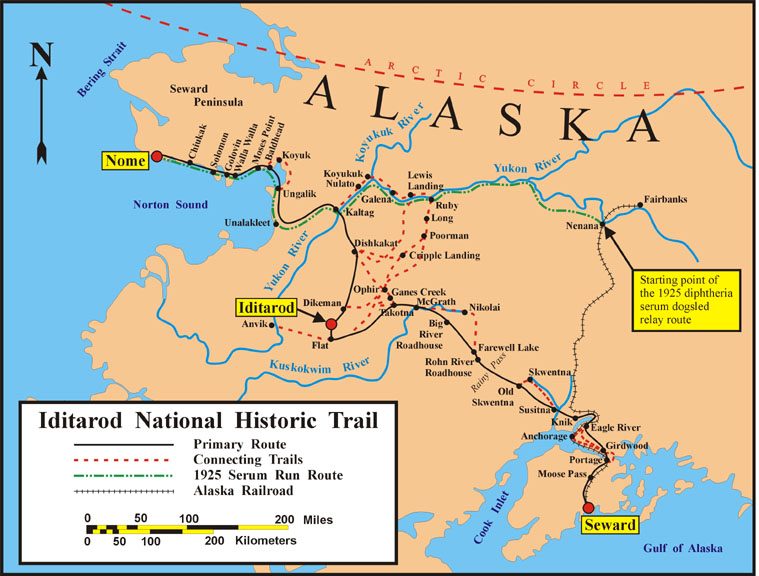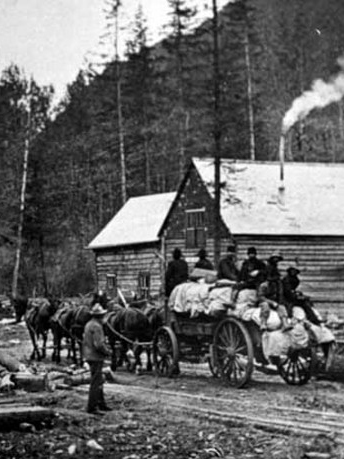|
Nome Mining District
The Nome mining district, also known as the Cape Nome mining district, is a gold mining district in the U.S. state of Alaska. It was discovered in 1898 when Erik Lindblom, Jafet Lindeberg and John Brynteson, the "Three Lucky Swedes", found placer gold deposits on Anvil Creek and on the Snake River few miles from the future site of Nome. Word of the strike caused a major gold rush to Nome in the spring of 1899. This was one of the first and was the biggest Alaskan gold rush in North America, only the California and Klondike gold rushes were larger. A chaotic and lawless scene ensued, with rampant claim-jumping, crooked judges, and not enough gold found for the 20,000 prospectors, gamblers, shop and saloon-keepers, and prostitutes living in the tent city on the beachfront tundra, at least not at first. Then someone thought to pan the red-and-black streaked beach sands. Within days, gold was found for tens of miles up and down the beach from Nome. More than a million dollar ... [...More Info...] [...Related Items...] OR: [Wikipedia] [Google] [Baidu] |
Cape Nome
Cape Nome is a headland on the Seward Peninsula in the U.S. state of Alaska. It is situated on the northern shore of Norton Sound, to the east of Nome also on Norton Sound. It is delimited by the Norton Sound to the south, Hastings Creek on the west, a lagoon on the east and an estuary formed by the Flambeau River and the Eldorado River. From the sea shore, Cape Nome extends inland by about , connected by road with Nome. Etymology Named Tolstoi ( "blunt" or "broad") by Mikhail Tebenkov (1833), it was named Sredul ("middle") on an 1852 Russian Hydrographic Service chart, with Tolstoi added as a synonym. The name Nome, used by Henry Kellett in 1849, first appears on British Admiralty charts after the John Franklin search expeditions. In 1901, Sir William Wharton wrote: "The name Cape Nome, which is off the entrance to Norton bay, first appears on our charts from an original of Kellett in 1849. I suppose the town gets its name from the same source, but what that is we have no ... [...More Info...] [...Related Items...] OR: [Wikipedia] [Google] [Baidu] |
Gold Rush
A gold rush or gold fever is a discovery of gold—sometimes accompanied by other precious metals and rare-earth minerals—that brings an onrush of miners seeking their fortune. Major gold rushes took place in the 19th century in Australia, New Zealand, Brazil, Chile, South Africa, the United States, and Canada while smaller gold rushes took place elsewhere. In the 19th century, the wealth that resulted was distributed widely because of reduced migration costs and low barriers to entry. While gold mining itself proved unprofitable for most diggers and mine owners, some people made large fortunes, and merchants and transportation facilities made large profits. The resulting increase in the world's gold supply stimulated global trade and investment. Historians have written extensively about the mass migration, trade, colonization, and environmental history associated with gold rushes. Gold rushes were typically marked by a general buoyant feeling of a "free-for-all" in income mob ... [...More Info...] [...Related Items...] OR: [Wikipedia] [Google] [Baidu] |
Gold Mining In Alaska
Gold mining in Alaska, a state of the United States, has been a major industry and impetus for exploration and settlement since a few years after the United States acquired the territory in 1867 from the Russian Empire. Russian explorers discovered placer gold in the Kenai River in 1848, but no gold was produced. Gold mining started in 1870 from placers southeast of Juneau, Alaska. Gold occurs and has been mined throughout Alaska; except in the vast swamps of the Yukon Flats, and along the North Slope between the Brooks Range and the Beaufort Sea. Areas near Fairbanks and Juneau, and Nome have produced most of Alaska's historical output and provide all current gold production . Nearly all of the large and many of the small placer-gold mines currently operating in the US are in Alaska. Seven modern large-scale hard-rock mines operated in Alaska ; five were gold-producing mines. There are also small-scale hard-rock gold-mining operations. In 2019 Alaska produced 539,390 troy ounc ... [...More Info...] [...Related Items...] OR: [Wikipedia] [Google] [Baidu] |
Open Pit Mining
Open-pit mining, also known as open-cast or open-cut mining and in larger contexts mega-mining, is a surface mining technique of extracting rock or minerals from the earth from an open-air pit, sometimes known as a borrow. This form of mining differs from extractive methods that require tunnelling into the earth, such as long wall mining. Open-pit mines are used when deposits of commercially useful ore or rocks are found near the surface. It is applied to ore or rocks found at the surface because the overburden is relatively thin or the material of interest is structurally unsuitable for tunnelling (as would be the case for cinder, sand, and gravel). In contrast, minerals that have been found underground but are difficult to retrieve due to hard rock, can be reached using a form of underground mining. To create an open-pit mine, the miners must determine the information of the ore that is underground. This is done through drilling of probe holes in the ground, then plotting eac ... [...More Info...] [...Related Items...] OR: [Wikipedia] [Google] [Baidu] |
USGS
The United States Geological Survey (USGS), formerly simply known as the Geological Survey, is a scientific agency of the United States government. The scientists of the USGS study the landscape of the United States, its natural resources, and the natural hazards that threaten it. The organization's work spans the disciplines of biology, geography, geology, and hydrology. The USGS is a fact-finding research organization with no regulatory responsibility. The agency was founded on March 3, 1879. The USGS is a bureau of the United States Department of the Interior; it is that department's sole scientific agency. The USGS employs approximately 8,670 people and is headquartered in Reston, Virginia. The USGS also has major offices near Lakewood, Colorado, at the Denver Federal Center, and Menlo Park, California. The current motto of the USGS, in use since August 1997, is "science for a changing world". The agency's previous slogan, adopted on the occasion of its hundredth anniv ... [...More Info...] [...Related Items...] OR: [Wikipedia] [Google] [Baidu] |
Iditarod Trail
The Iditarod Trail, also known historically as the Seward-to-Nome Trail, is a thousand-plus mile (1,600 km) historic and contemporary trail system in the US state of Alaska. The trail began as a composite of trails established by Alaskan native peoples. Its route crossed several mountain ranges and valleys and passed through numerous historical settlements en route from Seward to Nome. The discovery of gold around Nome brought thousands of people over this route beginning in 1908. Roadhouses for people and dog barns sprang up every 20 or so miles. By 1918 World War I and the lack of 'gold fever' resulted in far less travel. The trail might have been forgotten except for the 1925 diphtheria outbreak in Nome. In one of the final great feats of dog sleds, twenty drivers and teams carried the life-saving serum in 127 hours. Today, the Iditarod Trail Sled Dog Race serves to commemorate the part the trail and its dog sleds played in the development of Alaska, and the route an ... [...More Info...] [...Related Items...] OR: [Wikipedia] [Google] [Baidu] |
Iditarod, Alaska
Iditarod is an abandoned town in the Yukon-Koyukuk Census Area in the U.S. state of Alaska. It is presently located within the boundaries of the Flat Census Designated Place, which has no residents as of 2010. History The town of Iditarod was named after the Iditarod River. ''Iditarod'' comes from the Athabascan word ''Haidilatna''.Allan Curtis, "Iditarod's Newspapers: Optimist, Nugget, Pioneer" ''Alaska Journal'' 6 no.2 (Spring 1976) 78-83. On Christmas Day 1908, prospectors John Beaton and W.A. "Bill" Dikeman found gold on Otter Creek, a tributary to the Iditarod River. News of the find spread, and in the summer of 1909 miners arrived in the gold fields and built a small camp that was later known as Flat. People and supplies traveled to the gold fields by boat from the Yukon River, up the Innoko River, and up the Iditarod River to the current town site, a short walk from Flat. More gold was discovered, and a massive stampede headed for Flat in 1910. The steamboat ''T ... [...More Info...] [...Related Items...] OR: [Wikipedia] [Google] [Baidu] |
Seward, Alaska
Seward (Alutiiq: ; Dena'ina: ''Tl'ubugh'') is an incorporated home rule city in Alaska, United States. Located on Resurrection Bay, a fjord of the Gulf of Alaska on the Kenai Peninsula, Seward is situated on Alaska's southern coast, approximately by road from Alaska's largest city, Anchorage. With a population of 2,717 people as of the 2020 census, Seward is the fourth-largest city in the Kenai Peninsula Borough, behind Kenai, Homer, and the borough seat of Soldotna. The city is named for former U.S.A Secretary of State William H. Seward, who orchestrated the United States' purchase of Alaska from the Russian Empire in 1867 while serving in this position as part of President Andrew Johnson's administration. Seward is the southern terminus of the Alaska Railroad and the historic starting point of the original Iditarod Trail to Interior Alaska, with Mile 0 of the trail marked on the shoreline at the southern end of town. History In 1793, Alexander Baranov of the She ... [...More Info...] [...Related Items...] OR: [Wikipedia] [Google] [Baidu] |
Alaska Road Commission
The Board of Road Commissioners for Alaska, more commonly known as the Alaska Road Commission or ARC, was created in 1905 as a board of the U.S. War Department. It was responsible for the construction and improvement of many important Alaska highways, such as the Richardson Highway, Steese Highway, Elliot Highway and Edgerton Highway, among others. The commission was transferred to the Department of the Interior in 1932, and was absorbed by the Bureau of Public Roads, a division of the Commerce Department in 1956. Today, responsibility for road development and maintenance in Alaska lies with the Alaska Department of Transportation & Public Facilities. Background and Motivation The Alaska Interior was largely roadless up until about the 1870s, with only a network of trails established by the native people of Alaska, which Russian, and later American, traders and prospectors used as well. The Russians in Alaska stuck to coastal regions, and built almost no new trails or road ... [...More Info...] [...Related Items...] OR: [Wikipedia] [Google] [Baidu] |
California Gold Rush
The California Gold Rush (1848–1855) was a gold rush that began on January 24, 1848, when gold was found by James W. Marshall at Sutter's Mill in Coloma, California. The news of gold brought approximately 300,000 people to California from the rest of the United States and abroad. The sudden influx of gold into the money supply reinvigorated the American economy; the sudden population increase allowed California to go rapidly to statehood, in the Compromise of 1850. The Gold Rush had severe effects on Native Californians and accelerated the Native American population's decline from disease, starvation and the California genocide. The effects of the Gold Rush were substantial. Whole indigenous societies were attacked and pushed off their lands by the gold-seekers, called "forty-niners" (referring to 1849, the peak year for Gold Rush immigration). Outside of California, the first to arrive were from Oregon, the Sandwich Islands (Hawaii) and Latin America in late 1848. Of th ... [...More Info...] [...Related Items...] OR: [Wikipedia] [Google] [Baidu] |





.jpeg)

